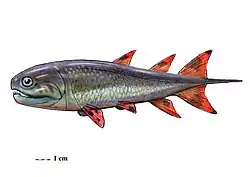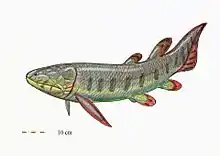Moenkopia
Moenkopia (meaning "for Moenkopi") is an extinct genus of prehistoric sarcopterygians from the Coelacanthidae[1] found in the Middle Triassic Moenkopi Formation of Arizona. The type, and only species, M. wellesi, was named in 1961 in honour of Samuel Paul Welles.[2] It is only known from the holotype, UMCP 36193, a partial skull consisting only of the basisphenoid that was collected in 1939 or 1940 by Samuel Welles and briefly noted on by him in 1947,[3] and other assorted specimens found before 2005 in the Radar Mesa by S. J. Nesbitt, W. G. Parker and R. B. Irmis.[4]
| Moenkopia | |
|---|---|
| Scientific classification | |
| Kingdom: | |
| Phylum: | |
| Class: | |
| Order: | |
| Family: | |
| Genus: | †Moenkopia Schaeffer & Gregory, 1961 |
| Binomial name | |
| †Moenkopia wellesi Schaeffer & Gregory, 1961 | |
See also
- Sarcopterygii
- List of sarcopterygians
- List of prehistoric bony fish
References
- P. L. Forey. 1998. History of the Coelacanth Fishes 1-440
- B. Schaeffer and J. T. Gregory. 1961. Coelacanth fishes from the continental Triassic of the western United States. American Museum Novitates 2036:1-18
- S. P. Welles. 1947. Vertebrates from the Upper Moenkopi Formation of northern Arizona. University of California Publications in Geological Sciences 27(7):241-294
- S. J. Nesbitt. 2005. The Moenkopi Formation along the Little Colorado River in eastern Arizona. In S. J. Nesbitt, W. G. Parker, R. B. Irmis (eds.), Guidebook to the Triassic Formations of the Colorado Plateau in northern Arizona, Mesa Southwest Museum Bulletin 9:13-23
This article is issued from Wikipedia. The text is licensed under Creative Commons - Attribution - Sharealike. Additional terms may apply for the media files.

.jpg.webp)



